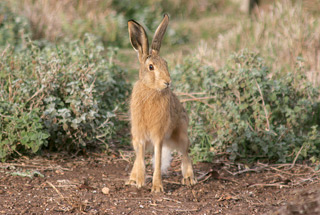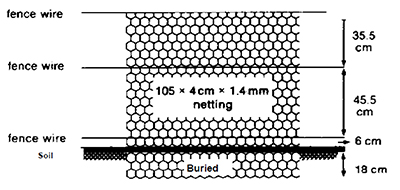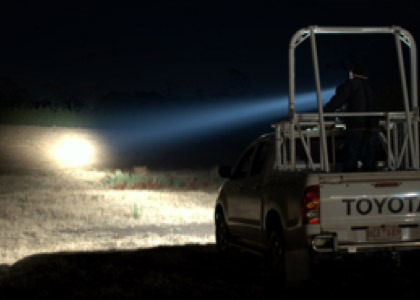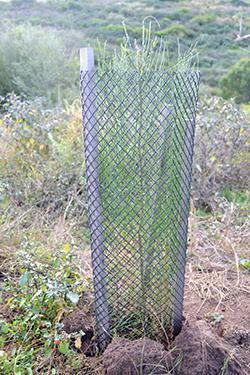Integrated hare control
Introduction

In Victoria, European hares (Lepus europaeus) are declared as established pest animals under the Catchment and Land Protection Act 1994.
Under the Act, all landowners have a responsibility to prevent the spread of, and as far as possible eradicate, established pest animals from their land.
Hares have been problematic in Australia since the 1860s. They are also a significant agricultural pest when their numbers reach high densities.
Hares often cause damage to newly tree planted seedlings/trees and vineyards by gnawing at bark and chewing the stems of young plants.
Hare biology and behaviour
Before designing your hare control program, it is important to understand hare behaviour and ecology. The following should be considered:
- Hares are most active from dusk to dawn.
- Unlike rabbits, hares do not shelter in warrens or burrows. They rest in shallow depressions in the ground (forms) near rocks, long grass and logs or branches.
- Hares are herbivores feeding mostly on leaves, stems and rhizomes of dry and green grasses.
- Hares may produce over 4 litters annually, each with 2 to 5 young (leverets). After 3 days, leverets will disperse to find separate hiding locations.
See European hare for more information about their characteristics and behaviour.
Managing hares on your property
Points to remember:
- It is important to control hares before they cause widespread damage.
- Effective hare control requires and integrated approach using a combination of control measures (not just one).It is also important to work with your neighbours, rather than on individual properties. Be aware native wildlife may share the same habitat as hares. Ensure your hare control program does not adversely affect native wildlife.
- If the intended hare control work may result in disturbance of native vegetation, culturally significant areas and waterways, please contact the responsible authorities prior to works being conducted. The responsible authorities may include local government, Agriculture Victoria, Aboriginal Affairs Victoria or the local Registered Aboriginal Party, and the local Catchment Management Authority. If you are planning to use dogs as part of your pest animal work, be mindful that there are specific requirements for the use of dogs for hunting. Under Section 28 of the Domestic Animals Act 1994, a person must not set or urge a dog to attack, bite, rush at or chase any animal except when hunting in accordance with the Prevention of Cruelty to Animals Act 1986.
- If you are planning to use chemicals to control hares, ensure all requirements of the Agricultural and Veterinary Chemicals (Control of Use) Act 1992 and Agriculture and Veterinary Chemicals (Control of Use) Regulations 2017 are met. This includes following the directions for use on the chemical label, keeping relevant chemical use records and only using 'restricted use chemicals' if you hold the required Agricultural Chemical User Permit or other relevant permit.
Planning your program
Good planning is essential for maximising the effectiveness of your hare control program and minimising the impact to other animals. Consider hare density, distribution and the habitat to determine what actions are most appropriate.
Work together
The best results are achieved when neighbours work together to control hares across the landscape, rather than just on individual properties. Talk to your neighbours and local Landcare group to work out a plan for coordinated action.
Conduct monitoring
Identify and map hare activity areas on your property. Hares are often found around:
- rocky outcrops
- Open fields
- wood heaps
- waterways
- weedy areas.
Assess hare activity on your property by spotlighting with a powerful torch or spotlight. You may also wish to use remote cameras to determine hare activity on your property. It is also important to identify and map areas where non-target species may be at risk.
Establishing a benchmark of hare numbers, and damage, before undertaking hare control will help gauge the effectiveness of your control program.
Use the information you have gained from monitoring to:
- target your control effort
- monitor the progress and success of your control program
- vary and improve your program
- minimise impact to other species.
It is important to continue to monitor hare numbers/damage after your control program so you can treat any re-infestation.
Aim to be hare free
Create a detailed hare management plan that has a specific aim and time-bound objectives to ensure the best outcomes. Eradication may not be possible in all areas, so ongoing monitoring and management is often required.
Use the right tools
Effective hare management requires an integrated approach using all control tools that suit your property. Every hare should be exposed to as many different control tools as possible to ensure those missed with one are accounted for with another. Making your property a hare unfriendly environment will also help prevent re-invasion and population recovery.
Timing
It is best to implement your hare control program before the peak of their damage. There is often a lull in breeding during Autumn, this is when the population will be most stable.
Evaluate your success
Conduct monitoring before, during and after your control program.
Consider:
- Have you observed hares?
- Are you still experiencing damage caused by hares?
- Is the impact of hares above or below acceptable thresholds?
- What is working well? What could be improved?
- Do you need to change your plan? Have you managed all the risks?
Follow up
Continue to monitor hare numbers and damage and when you see signs of hare activity again, implement control actions immediately.
Management techniques
Above ground harbour removal, exclusion fencing, shooting, tree guards, biological control, repellents, and trapping are useful tools for managing the impacts of hares on your property, so it is important to include as many of these techniques as possible in your integrated hare control program.
Above-ground harbour removal
Hare survival is better where they have ready access to safe haven or shelter. Such harbour may be:
- piles of rubbish or debris
- patches of woody weeds
- tall grasses and reeds
- shelter belts or rocks.
Trim under all hedges and thickets of scrub to remove low branches and destroy possible harbour. Keep pastures well grazed.
Remove prickly and woody weeds (such as gorse, boxthorn and blackberries), rubbish piles and old machinery. Fence off rock piles, building materials, hay bales and woodpiles or store them in a manner that does not create a hiding place for hares.
Remember, that while fallen timber may provide harbour for hares, it may also provide habitat for native wildlife. If you are planning to remove fallen timber, you must ensure that you do not affect native wildlife.
Exclusion fencing
Exclusion fencing involves constructing a fence around hare sensitive areas on your property such as:
- shelterbelts
- revegetation sites
- crops
- gardens
Ask for 'rabbit proof fencing' when sourcing fencing materials.
A minimum of 17cm of the fencing wire netting is buried in the ground, or the lower section of the wire netting is angled to lie on the ground facing in the direction of possible hare entry. The wire must be held down securely with pegs, rocks or timber. The remainder of the mesh must be securely fixed to a suitable support fence so that it reaches a minimum of 88cm above ground.
Exclusion fencing is expensive. It requires regular maintenance to ensure there are no gaps. With proper maintenance fences should last up to 20 years.
One consequence of this fencing is that the movement of some native animals may be limited.
Minimum specifications
- Use standard rabbit netting that is 105cm width 4cm mesh diameter × 1.4mm wire diameter.
- Make sure support fence can withstand stock or native animal forces.
- Ensure that rabbit netting is fixed so that it reaches at least 88cm above the ground.
- Where netting is buried, it must be buried to a minimum of 170mm.
- Where netting is bent to lay on the ground surface, it must be held down with pegs, rocks or timber.
- There should be suitable rabbit/hare-proof gates at all breaks in the fence.
General support fencing needs
- Use sturdy posts driven at least 45cm into the ground (either rammed or dug in).
- Spacing between posts and star pickets should be determined by soil type, topography and required strength of the fence.
- It is best to have fences erected by experienced or professional fencers.
Exclusion fencing will help to reduce damage to sensitive areas by deterring hares, but hares have been known to occasionally climb fences.
 Shooting
Shooting
Shooting is a target-specific and humane form of hare control. Night-time shooting of hares with the aid of a spotlight or thermal scopes is most effective. It is labour intensive but is an effective management tool when implemented as part of an integrated pest management program.
Due to the highly mobile nature of hares, shooting will be most effective when implemented at the landscape scale in coordination with neighbouring land holders.
The use of firearms to control hares must conform to relevant firearm legislation and be integrated with other control methods.
Other management techniques
Tree guards
Tree guards are essential for protecting seedlings in hare-prone areas. Generally, larger and stronger tree guards will provide the best protection to young plants.
It may be more cost-effective when planting large areas to hare-proof fence the whole site and remove all hares inside the fenced area prior to planting.
Hares have a habit of grazing along a line of trees, crops or fence lines. When conducting planting activities, you may wish to stagger your rows and leave regular gaps along rows. This pattern of planting can deter a hare from grazing along the whole length of the revegetation area by interrupting its preferred feeding habits.
Biological control
There are no current biological control agents for the control of hares in Australia. Unlike rabbits, hares are not affected by myxomatosis or rabbit haemorrhagic disease virus (RHDV1K1 or Czech strain). However, a naturally occurring form of the calicivirus, RHDV2, that is now present in Australia has been confirmed to kill hares.
European Brown Hare Syndrome is a virus specific to hares that is closely related to rabbit haemorrhagic disease (calici virus). This virus affects hare populations in other countries, but it has not been detected in Australia.
Repellents
Chemical repellents are designed to reduce herbivore grazing by imitating the smell of a predator or making the plant unpalatable. The repellents are placed on plant surface or around the base of plants. Repellents are designed to give short-term protection during critical stages of growth.
There are a number of commercial chemical repellents available. Consult your local horticulturalist and check the product label to ensure that a repellent is suitable for your intended use.
Trapping
Trapping is not a cost-effective hare control technique, as it is labour intensive. It is best implemented to target specific problem individuals where other control options are not suited.
Any trapping of hares must be carried out in accordance with the requirements of the Prevention of Cruelty to Animals Act 1986 (POCTA) and associated regulations.
Trapping has several animal welfare implications and anyone considering trapping should read important further information about traps.
Image credits
Figure 1 courtesy of Phil Stott